Pharmacokinetics and Withdrawal Times of Cefotaxime in White Leg Shrimp (Litopenaeus vannamei) after Oral Administration
Abstract
1. Introduction
2. Materials and Methods
2.1. Chemicals
2.2. Experimental Shrimp
2.3. Pharmacokinetics Experiment
2.4. Determination of the Withdrawal Times of Cefotaxime and Hepatopancreas Histological Observation
2.5. Cefotaxime Quantification
2.5.1. Sample Extraction and Chromatographic and Mass Spectrometry Conditions
2.5.2. Quantification of Cefotaxime Residues
2.5.3. Method Validation
2.6. Pharmacokinetics Data Analysis
2.7. Withdrawal Times Calculation
2.8. Histological Analysis
3. Results
3.1. LC-MS/MS Method Validation
3.2. Pharmacokinetics (PK) Parameters of Cefotaxime in Plasma and Hepatopancreas of White Leg Shrimp
3.3. Depletion of Cefotaxime in Muscle of White Leg Shrimp
3.4. Hepatopancreas Histology
4. Discussion
4.1. Method Validation for CFT Analysis
4.2. Cefotaxime Pharmacokinetics in White Leg Shrimp
4.3. Cefotaxime Depletion in White Leg Shrimp
4.4. The Effect of Cefotaxime on White Leg Shrimp Hepatopancreas Histology
5. Conclusions
Author Contributions
Funding
Institutional Review Board Statement
Informed Consent Statement
Data Availability Statement
Acknowledgments
Conflicts of Interest
References
- Vietnam Association of Seafood Exporters and Producers (VASEP). Vietnam Aquaculture and Fisheries Overview. 2024. Available online: https://vasep.com.vn/gioi-thieu/tong-quan-nganh (accessed on 30 May 2024).
- Vietnam Association of Seafood Exporters and Producers (VASEP). 2022. Available online: https://vasep.com.vn/san-pham-xuat-khau/tom/xuat-nhap-khau/xuat-khau-tom-dat-4-3-ty-usd-nam-2022-26128.html (accessed on 22 March 2023).
- Phu, T.M.; Vinh, P.Q.; Dao, N.L.A.; Viet, L.Q.; Thinh, N.Q. Chemical use in intensive white-leg shrimp aquaculture in Ben Tre province, Vietnam. Int. J. Sci. Res. Publ. 2019, 9, 812–815. [Google Scholar] [CrossRef]
- Thinh, N.Q.; Maita, M.; Phu, T.M. Chemical use in intensive white leg shrimp aquaculture in Tra Vinh province, Vietnam. Can Tho Univ. J. Sci. 2020, 56, 70–77. [Google Scholar] [CrossRef]
- Chi, T.T.K.; Clausen, J.H.; Van, P.T.; Tersbøl, B.; Dalsgaard, A. Use practices of antimicrobials and other compounds by shrimp and fish farmers in Northern Vietnam. Aquac. Rep. 2017, 7, 40–47. [Google Scholar] [CrossRef]
- Phu, T.M.; Phuong, N.T.; Dung, T.T.; Hai, D.M.; Son, V.N.; Rico, A.; Clausen, J.H.; Madsen, H.; Murray, F.; Dalsgaard, A. An evaluation of fish health-management practices and occupational health hazards associated with Pangasius catfish (Pangasianodon hypophthalmus) aquaculture in the Mekong Delta, Vietnam. Aquac. Res. 2016, 47, 2778–2794. [Google Scholar] [CrossRef]
- Rico, A.; Oliveira, R.; McDonough, S.; Matser, A.; Khatikarn, J.; Satapornvanit, K.; Nogueira, A.J.A.; Soares, A.M.V.M.; Domingues, I.; Van den Brink, P.J. Use, fate and ecological risks of antibiotics applied in tilapia cage farming in Thailand. Environ. Pollut. 2014, 191, 8–16. [Google Scholar] [CrossRef]
- Rapid Alert System for Food and Feed (RASFF). 2022. Available online: https://food.ec.europa.eu/safety/rasff_en (accessed on 10 March 2023).
- Bermúdez-Almada, M.C.; Pérez-Tello, M.G.; Valenzuela-Quintanar, A.I.; Vázquez-Moreno, L. Oxytetracycline residues in cultured white shrimp tissue by HPLC and a microbial receptor assay. J. Food Sci. 1999, 64, 638–640. [Google Scholar] [CrossRef]
- Ma, R.; Wang, Y.; Zou, X.; Fu, G.; Li, C.; Fan, P.; Fang, W. Pharmacokinetics of oxytetracycline in Pacific white shrimp, Penaeus vannamei, after oral administration of a single-dose and multiple-doses. Aquaculture 2019, 512, 734348. [Google Scholar] [CrossRef]
- Nogueira-Lima, A.C.; Gesteira, T.C.V.; Mafezoli, J. Oxytetracycline residues in cultivated marine shrimp (Litopenaeus vannamei Boone, 1931) (Crustacea, Decapoda) submitted to antibiotic treatment. Aquaculture 2006, 254, 748–757. [Google Scholar] [CrossRef]
- Reed, L.A.; Siewicki, T.C.; Shah, J.C. Pharmacokinetics of oxytetracycline in the white shrimp, Litopenaeus setiferus. Aquaculture 2004, 232, 11–28. [Google Scholar] [CrossRef]
- Uno, K.; Aoki, T.; Kleechaya, W.; Tanasomwang, V.; Ruangpan, L. Pharmacokinetics of oxytetracycline in black tiger shrimp, Penaeus monodon, and the effect of cooking on the residues. Aquaculture 2006, 254, 24–31. [Google Scholar] [CrossRef]
- Wang, W.; Lin, H.; Xue, C.; Khalid, J. Elimination of chloramphenicol, sulphamethoxazole and oxytetracycline in shrimp, Penaeus chinensis following medicated-feed treatment. Environ. Int. 2004, 30, 367–373. [Google Scholar] [CrossRef] [PubMed]
- Fang, W.; Li, G.; Zhou, S.; Li, X.; Hu, L.; Zhou, J. Pharmacokinetics and tissue distribution of thiamphenicol and florfenicol in Pacific white shrimp Litopenaeus vannamei in freshwater following oral administration. J. Aquat. Anim. Health. 2013, 25, 83–89. [Google Scholar] [CrossRef] [PubMed]
- Ren, X.; Pan, L.; Wang, L. Tissue distribution, elimination of florfenicol and its effect on metabolic enzymes and related genes expression in the white shrimp Litopenaeus vannamei following oral administration. Aquac. Res. 2016, 47, 1584–1595. [Google Scholar] [CrossRef]
- Maftuch; Aziz, K.; Eslfitri, D.; Sanoesi, E.; Prihanto, A.A. Enrofloxacin stimulates cell death in several tissues of vannamei shrimp (Litopenaeus vannamei). Comp. Clin. Pathol. 2017, 26, 249–254. [Google Scholar] [CrossRef]
- Fang, X.; Zhou, J.; Liu, X. Pharmacokinetics and tissue distribution of enrofloxacin after single intramuscular injection in Pacific white shrimp. J. Vet. Pharmacol. Ther. 2018, 41, 148–154. [Google Scholar] [CrossRef] [PubMed]
- Ma, R.; Huang, L.; Wei, W.; Wang, Y.; Zou, X.; Zhou, J.; Li, X.; Fang, W. Pharmacokinetics of enrofloxacin and its metabolite ciprofloxacin in Pacific white shrimp Litopenaeus vannamei after multiple-dose oral administration. Fish. Sci. 2018, 84, 869–876. [Google Scholar] [CrossRef]
- Douny, C.; Widart, J.; De Pauw, E.; Silvestre, F.; Kestemont, P.; Tu, H.T.; Phuong, N.T.; Maghuin-Rogister, G.; Scippo, M.L. Development of an analytical method to detect metabolites of nitrofurans: Application to the study of furazolidone elimination in Vietnamese black tiger shrimp (Penaeus monodon). Aquaculture 2013, 376, 54–58. [Google Scholar] [CrossRef]
- Ma, R.; Wang, Y.; Zou, X.; Hu, K.; Sun, B.; Fang, W.; Fu, G.; Yang, X. Pharmacokinetics of sulfamethoxazole and trimethoprim in Pacific white shrimp, Litopenaeus vannamei, after oral administration of single-dose and multiple-dose. Environ. Toxicol. Pharmacol. 2017, 52, 90–98. [Google Scholar] [CrossRef]
- Plosker, G.L.; Foster, R.H.; Benfield, P. Cefotaxime. PharmacoEconomics 1998, 13, 91–106. [Google Scholar] [CrossRef]
- Thinh, N.Q.; Phu, T.M. Chapter 3 Drugs and chemicals use in white leg shrimp culture. In Drugs and Chemicals Use in Aquaculture; Can Tho University Publisher: Can Tho City, Vietnam, 2021; pp. 25–41. [Google Scholar]
- Carmine, A.A.; Brogden, R.N.; Heel, R.C.; Speight, T.M.; Avery, G.S. Cefotaxime. Drugs 1983, 25, 223–289. [Google Scholar] [CrossRef]
- Song, C.; Zhang, C.; Fan, L.; Qiu, L.; Wu, W.; Meng, S.; Hu, G.; Kamira, B.; Chen, J. Occurrence of antibiotics and their impacts to primary productivity in fishponds around Tai Lake, China. Chemosphere 2016, 161, 127–135. [Google Scholar] [CrossRef] [PubMed]
- Lin, H.; Chen, L.; Li, H.; Luo, Z.; Lu, J.; Yang, Z. Pharmaceutically active compounds in the Xiangjiang River, China: Distribution pattern, source apportionment, and risk assessment. Sci. Total Environ. 2018, 636, 975–984. [Google Scholar] [CrossRef] [PubMed]
- Ali, N.G.; Ali, T.E.S.; Aboyadak, I.M.; Elbakry, M.A. Controlling Pseudomonas aeruginosa infection in Oreochromis niloticus spawners by cefotaxime sodium. Aquaculture 2021, 544, 737107. [Google Scholar] [CrossRef]
- Altayban, A.; Kandeel, M.; Tahoun, A.; Al-Nazawi, M. Cefotaxime pharmacokinetics in Arabian camel (Camelus dromedarius) calves after single intravenous injection. Trop. Anim. Health Prod. 2020, 52, 887–891. [Google Scholar] [CrossRef] [PubMed]
- Atef, M.; Ramadan, A.; Afifi, N.A.; Youssef, S.A.H. Pharmacokinetic profile of cefotaxime in goats. Res. Vet. Sci. 1990, 49, 34–38. [Google Scholar] [CrossRef] [PubMed]
- Golocorbin-Kon, S.; Mikov, M.; Arafat, M.; Lepojevic, Z.; Mikov, I.; Sahman-Zaimovic, M.; Tomic, Z. Cefotaxime pharmacokinetics after oral application in the form of 3α,7α-dihydroxy-12-keto-5β-cholanate microvesicles in rat. Eur. J. Drug Metab. Pharmacokinet. 2009, 34, 31–36. [Google Scholar] [CrossRef] [PubMed]
- Sharma, S.K.; Srivastava, A.K.; Deore, M.D. Pharmacokinetics of cefotaxime in hepatic-dysfunctioned buffalo calves. Vet. Arh. 2005, 75, 339–348. [Google Scholar]
- Attia, Y.A.; Bovera, F.; Abd-Elhamid, A.E.-H.E.; Calabrò, S.; Mandour, M.A.; Al-Harthi, M.A.; Hassan, S.S. Evaluation of the carryover effect of antibiotic, bee pollen and propolis on growth performance, carcass traits and splenic and hepatic histology of growing rabbits. J. Anim. Physiol. Anim. Nutr. 2019, 103, 947–958. [Google Scholar] [CrossRef] [PubMed]
- Nale, L.P.; More, P.R.; More, B.K.; Ghumare, B.C.; Shendre, S.B.; Mote, C.S. Protective effect of Carica papaya L. seed extract in gentamicin induced hepatotoxicity and nephrotoxicity in rats. Int. J. Pharm. Bio. Sci. 2012, 3, 508–515. [Google Scholar]
- Augusto, J.; Smith, B.; Smith, S.; Robertson, J.; Reimschuessel, R. Gentamicin-induced nephrotoxicity and nephroneogenesis in Oreochromis nilotica, a tilapian fish. Dis. Aquat. Organ. 1996, 26, 49–58. [Google Scholar] [CrossRef]
- Bojarski, B.; Kot, B.; Witeska, M. Antibacterials in Aquatic Environment and Their Toxicity to Fish. Pharmaceuticals 2020, 13, 189. [Google Scholar] [CrossRef] [PubMed]
- Islam, M.T.; Mostakim, G.M.; Azom, M.G.; Rahman, U.O.; Khan, M.M.; Quader Khan, M.G.; Islam, M.S. Effect of an amalgamated antibiotic and its connection to cyto-genotoxicity and histo-architectural malformations in stinging catfish. Emerg. Contam. 2022, 8, 381–390. [Google Scholar] [CrossRef]
- Manna, S.K.; Bera, A.K.; Das, N.; Bandopadhyay, C.; Baitha, R.; Sen Ghadei, S.; Das, B.K.; Kumar, A.; Ravindran, R.; Krishna, N.; et al. Determination of biosafety of the antibiotic oxytetracycline hydrochloride in Pangasianodon hypophthalmus. Aquac. Res. 2021, 52, 2470–2480. [Google Scholar] [CrossRef]
- Rodrigues, S.; Antunes, S.C.; Nunes, B.; Correia, A.T. Histopathological effects of the antibiotic erythromycin on the freshwater fish species Oncorhynchus mykiss. Ecotoxicol. Environ. Saf. 2019, 181, 1–10. [Google Scholar] [CrossRef] [PubMed]
- Zhang, Y.; Wang, L.; Zhuang, H.; Li, X.; Gao, X.; An, Z.; Liu, X.; Yang, H.; Wei, W.; Zhang, X. Excessive use of enrofloxacin leads to growth inhibition of juvenile giant freshwater prawn Macrobrachium rosenbergii. Ecotoxicol. Environ. Saf. 2019, 169, 344–352. [Google Scholar] [CrossRef] [PubMed]
- Pang, H.; Zheng, K.; Wang, W.; Zheng, M.; Liu, Y.; Yin, H.; Zhang, D. Cefotaxime Exposure-Caused Oxidative Stress, Intestinal Damage and Gut Microbial Disruption in Artemia sinica. Microorganisms 2024, 12, 675. [Google Scholar] [CrossRef] [PubMed]
- Caceci, T.; Neck, K.F.; Lewis, D.D.H.; Sis, R.F. Ultrastructure of the hepatopancreas of the Pacific white shrimp, Penaeus vannamei (Crustacea: Decapoda). J. Mar. Biol. Assoc. U. K. 1988, 68, 323–337. [Google Scholar] [CrossRef]
- Lightner, D.V. A Handbook of Shrimp Pathology and Diagnostic Procedures for Diseases of Cultured Penaeid Shrimp; World Aquaculture Society: Baton Rouge, LA, USA, 1996. [Google Scholar]
- USDA. Screening and Confirmation of β-Lactam Antibiotics by HPLC-MS/MS; CLG-BLAC; United States Department of Agriculture, Food Safety and Inspection Service, Office of Public Health Science: Washington, DC, USA, 2011; Volume 2, pp. 1–17. [Google Scholar]
- Phu, T.M.; Em, N.T.; Thinh, N.Q.; Phuong, N.T.; Dalgaard, A.; Scippo, M.-L.; Devreese, M.; Croubels, S. Pharmacokinetics and muscle residue depletion of amoxicillin in cage cultured hybrid red tilapia (Oreochromis mossambicus × Oreochromis niloticus). Aquaculture 2019, 505, 206–211. [Google Scholar] [CrossRef]
- European Commission. Commission Implementing Regulation (EU) 2021/808 of 22 March 2021 on the Performance of Analytical Methods for Residues of Pharmacologically Active Substances Used in Food-Producing Animals and on the Interpretation of Results as Well as on the Methods to be Used for Sampling and Repealing Decisions 2002/657/EC and 98/179/EC; European Commission: Brussels, Belgium, 2021. [Google Scholar]
- ICH. Topic Q2 (R1) Validation of Analytical Procedures: Text and Methodology; ICH: Montréal, Canada, 2005; p. 17. [Google Scholar]
- European Medicines Agency (EMA). 2022. Available online: https://www.ema.europa.eu/en/documents/scientific-guideline/adopted-guideline-determination-withdrawal-periods-edible-tissues-revision-2_en.pdf (accessed on 10 May 2023).
- Hekman, P. Withdrawal-Time Calculation Program WT1. 4; BRD Agency for the Registration of Veterinary Medicinal Products: Wageningen, The Netherlands, 2004; pp. 1–8. [Google Scholar]
- Yang, Z.B.; Zhao, Y.L.; Li, N.; Yang, J. Effect of waterborne copper on the microstructures of gill and hepatopancreas in Eriocheir sinensis and its induction of metallothionein synthesis. Arch. Environ. Contam. Toxicol. 2007, 52, 222–228. [Google Scholar] [CrossRef]
- Fedorova, G.; Nebesky, V.; Randak, T.; Grabic, R. Simultaneous determination of 32 antibiotics in aquaculture products using LC-MS/MS. Chem. Pap. 2014, 68, 29–36. [Google Scholar] [CrossRef]
- Lopes, R.P.; Reyes, R.C.; Romero-González, R.; Vidal, J.L.M.; Frenich, A.G. Multiresidue determination of veterinary drugs in aquaculture fish samples by ultra high performance liquid chromatography coupled to tandem mass spectrometry. J. Chromatogr. B 2012, 895, 39–47. [Google Scholar] [CrossRef] [PubMed]
- Saxena, S.K.; Rangasamy, R.; Krishnan, A.A.; Singh, D.P.; Uke, S.P.; Malekadi, P.K.; Sengar, A.S.; Mohamed, D.P.; Gupta, A. Simultaneous determination of multi-residue and multi-class antibiotics in aquaculture shrimps by UPLC-MS/MS. Food Chem. 2018, 260, 336–343. [Google Scholar] [CrossRef] [PubMed]
- Dutta, B.P.; Debnath, S.C.; Mandal, T.K.; Chakraborty, A.K. Modification of pharmacokinetics of cefotaxime in uranyl nitrate-induced renal damage in black bengal goats. J. Vet. Sci. 2019, 5, 1–3. [Google Scholar] [CrossRef]
- Fayette, M.A.; Rose, J.B.; Hunter, R.P.; Bowman, M.R.; Proudfoot, J.S. Naïve-pooled pharmacokinetics of ceftiofur crystalline free acid after single intramuscular administration in smooth dogfish (Mustelus canis). J. Zoo Wildl. Med. 2019, 50, 466–469. [Google Scholar] [CrossRef] [PubMed]
- Khalil, W.F.; Shaheen, H.M.; Abdou, R.H. Ceftiofur pharmacokinetics in Nile tilapia Oreochromis niloticus after intracardiac and intramuscular administrations. Dis. Aquat. Organ. 2016, 121, 29–35. [Google Scholar] [CrossRef] [PubMed]
- Seo, J.S.; Kwon, M.G.; Hwang, J.Y.; Hwang, S.D.; Kim, D.H.; Bae, J.S.; Park, K.H.; Lee, J.H. Estimation of pharmacological properties of ceftiofur, an injectable cephalosporin antibiotic, for treatment of streptococcosis in cultured olive flounder Paralichthys olivaceus. Aquac. Res. 2021, 52, 831–841. [Google Scholar] [CrossRef]
- Wu, G.; Meng, Y.; Zhu, X.; Huang, C. Pharmacokinetics and tissue distribution of enrofloxacin and its metabolite ciprofloxacin in the Chinese mitten-handed crab, Eriocheir sinensis. Anal. Biochem. 2006, 358, 25–30. [Google Scholar] [CrossRef] [PubMed]
- Owen, S.F.; Giltrow, E.; Huggett, D.B.; Hutchinson, T.H.; Saye, J.; Winter, M.J.; Sumpter, J.P. Comparative physiology, pharmacology and toxicology of β-blockers: Mammals versus fish. Aquat. Toxicol. 2007, 82, 145–162. [Google Scholar] [CrossRef] [PubMed]
- Craig, W.A. Interrelationship between pharmacokinetics and pharmacodynamics in determining dosage regimens for broad-spectrum cephalosporins. Diagn. Microbiol. Infect. Dis. 1995, 22, 89–96. [Google Scholar] [CrossRef]
- Gustafsson, I.; Löwdin, E.; Odenholt, I.; Cars, O. Pharmacokinetic and pharmacodynamic parameters for antimicrobial effects of cefotaxime and amoxicillin in an in vitro kinetic model. Antimicrob. Agents Chemother. 2001, 45, 2436–2440. [Google Scholar] [CrossRef]
- Avunje, S.; Patil, P.K.; Ezaz, W.; Praveena, E.; Ray, A.; Viswanathan, B.; Alavandi, S.V.; Puthiyedathu, S.K.; Vijayan, K.K. Effect of oxytetracycline on the biosafety, gut microbial diversity, immune gene expression and withdrawal period in Pacific whiteleg shrimp, Penaeus vannamei. Aquaculture 2021, 543, 736957. [Google Scholar] [CrossRef]
- Berezhinskaia, V.V.; Dolgova, G.V.; Egorenko, G.G.; Svinogeeva, T.P.; Zebrev, A.I.; Smolkina, T.V.; Shtegel’man, L.A.; Nikitin, A.V. General toxic and organotropic properties of cefotaxime in acute and chronic experiments. Antibiot. Khimioterapiia Antibiot. Chemoterapy Sic. 1990, 35, 25–27. [Google Scholar]
- US EPA. Oxytetracycline Hydrochloride: Human Health Risk Assessment for New Uses on Fruiting Vegetables (CG 8) and Cucurbit Vegetables (CG 9); US EPA: Washington, DC, USA, 2012. [Google Scholar]
- Pathak, M.; Krishna Reddy, A.; Kulkarni, M.; Harikrishna, V.; Srivastava, P.; Chadha, N.; Lakra, W. Histological Alterations in the Hepatopancreas and Growth Performance of Pacific White Shrimp (Litopenaeus vannamei, Boone 1931) Reared in Potassium Fortified Inland Saline Ground Water. Int. J. Curr. Microbiol. Appl. Sci. 2018, 7, 3531–3542. [Google Scholar] [CrossRef]
- Bray, W.A.; Williams, R.R.; Lightner, D.V.; Lawrence, A.L. Growth, survival and histological responses of the marine shrimp, Litopenaeus vannamei, to three dosage levels of oxytetracycline. Aquaculture 2006, 258, 97–108. [Google Scholar] [CrossRef]
- Romano, N.; Koh, C.B.; Ng, W.K. Dietary microencapsulated organic acids blend enhances growth, phosphorus utilization, immune response, hepatopancreatic integrity and resistance against Vibrio harveyi in white shrimp, Litopenaeus vannamei. Aquaculture 2015, 435, 228–236. [Google Scholar] [CrossRef]
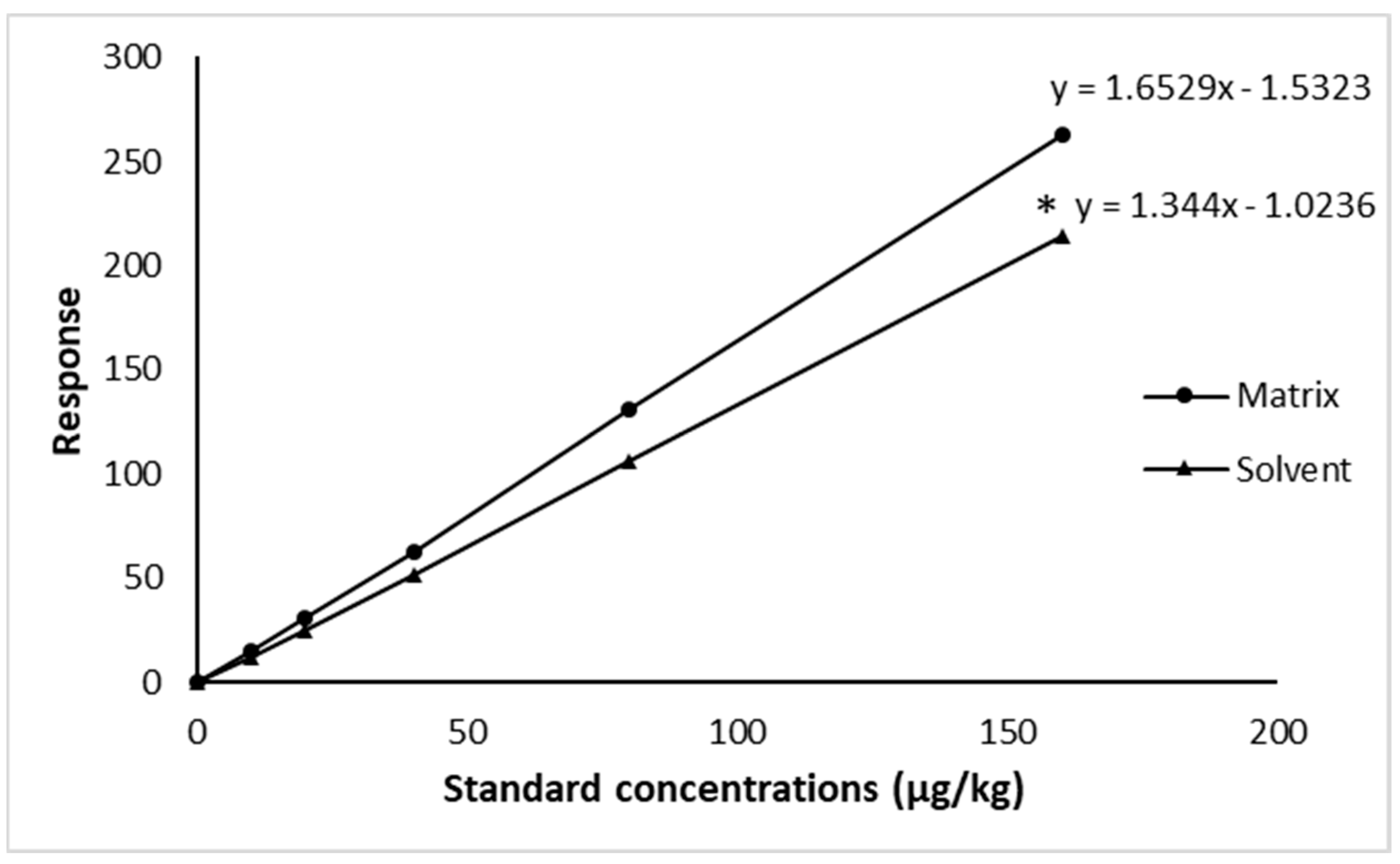
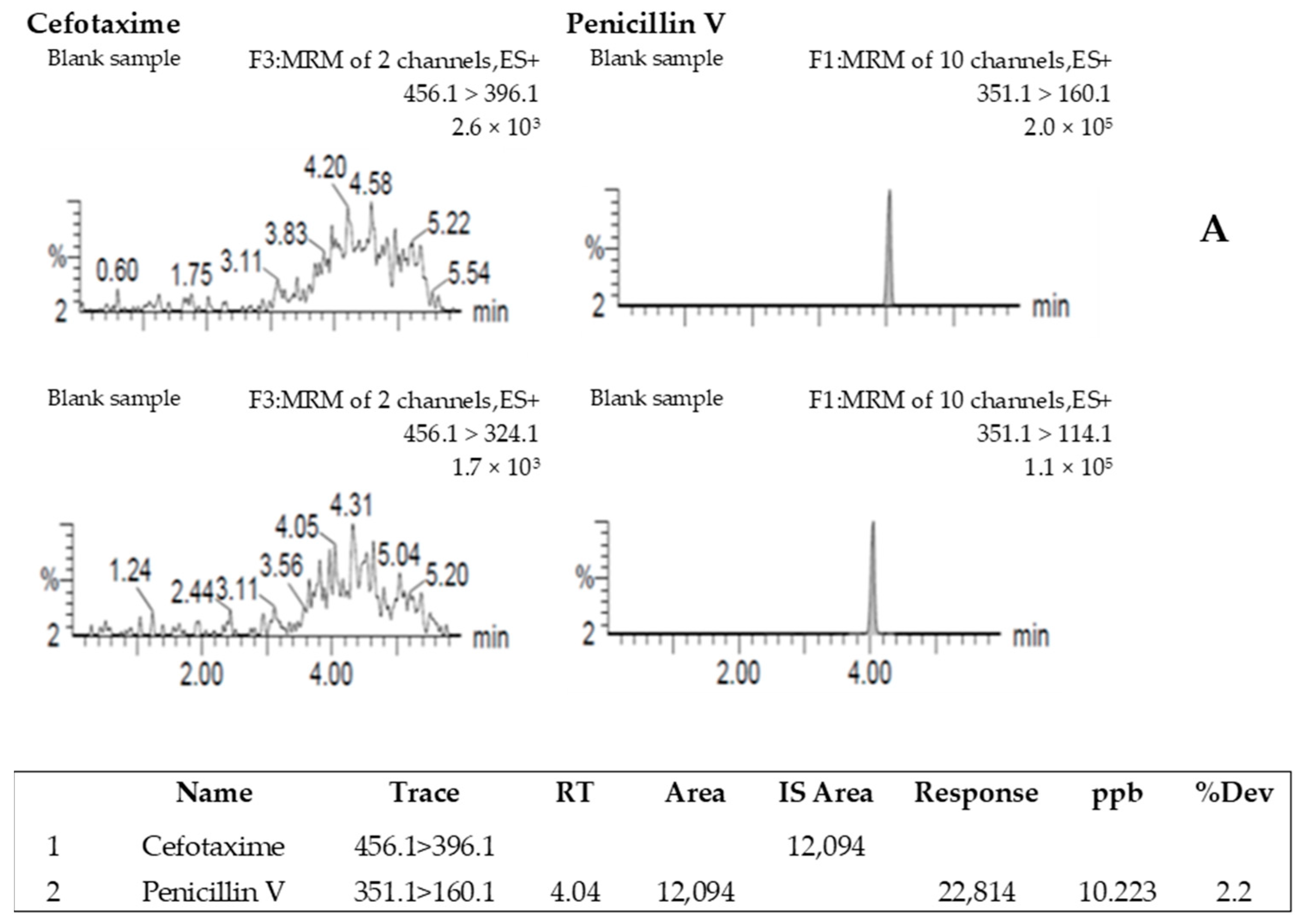
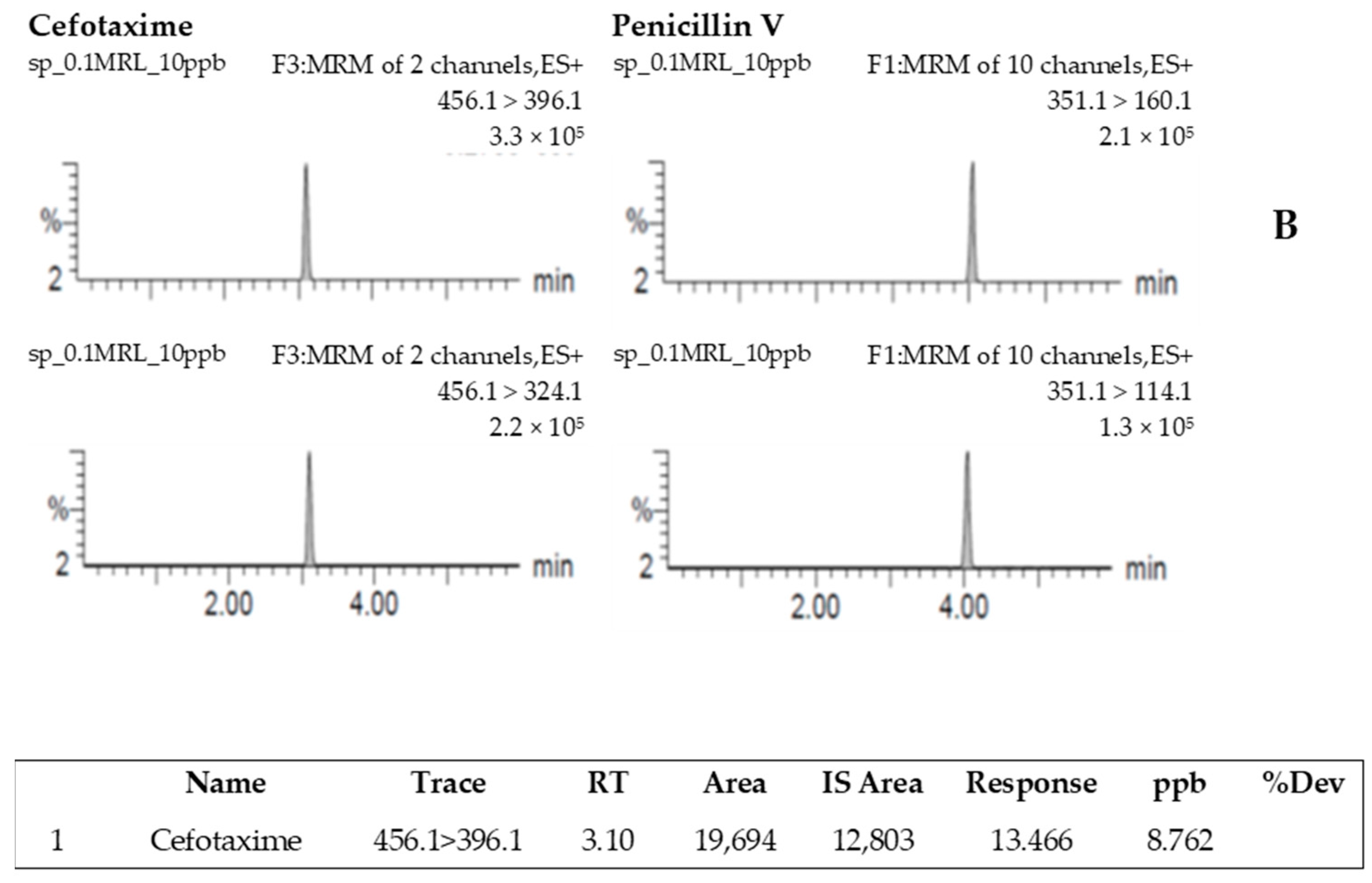
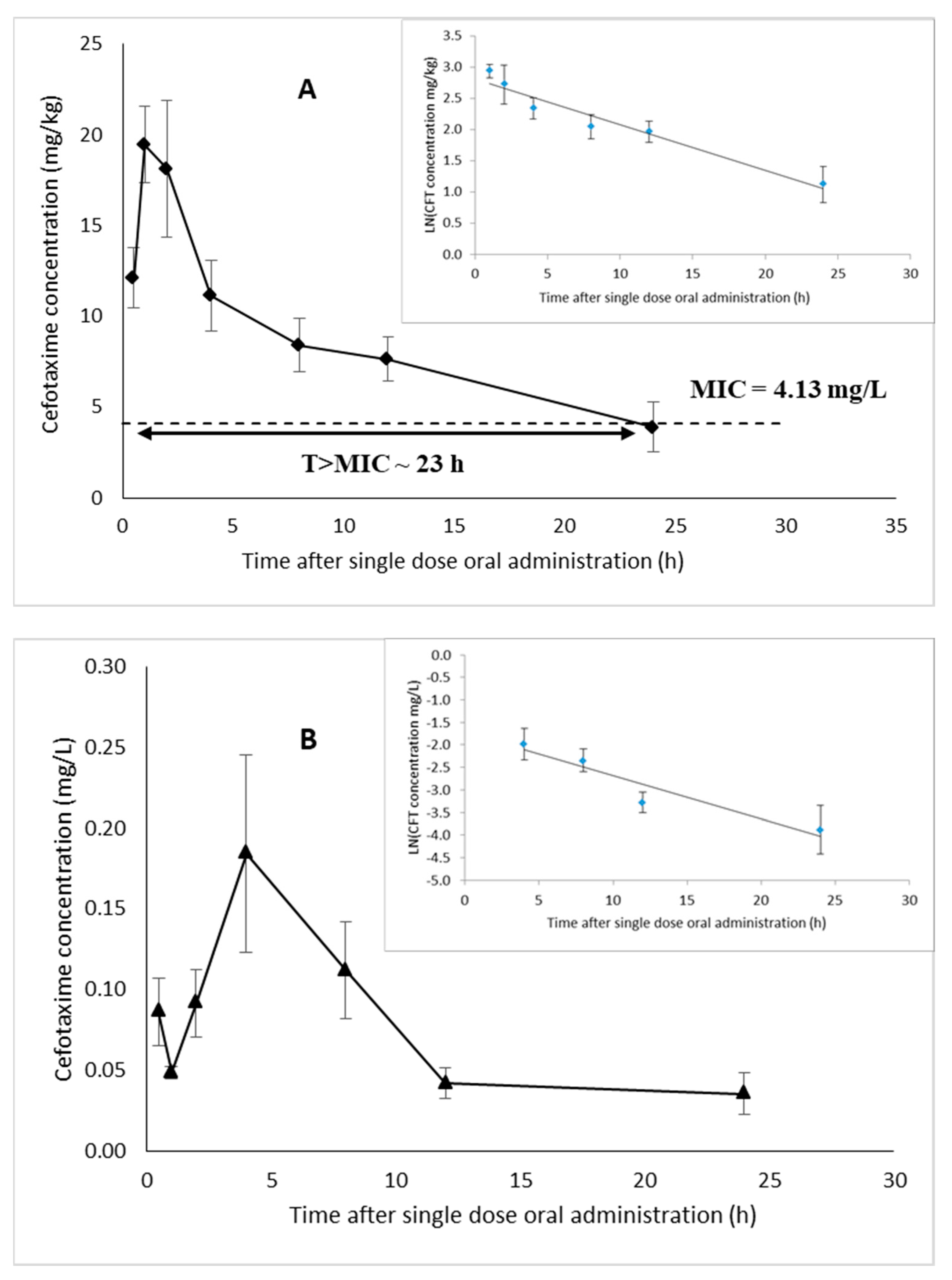

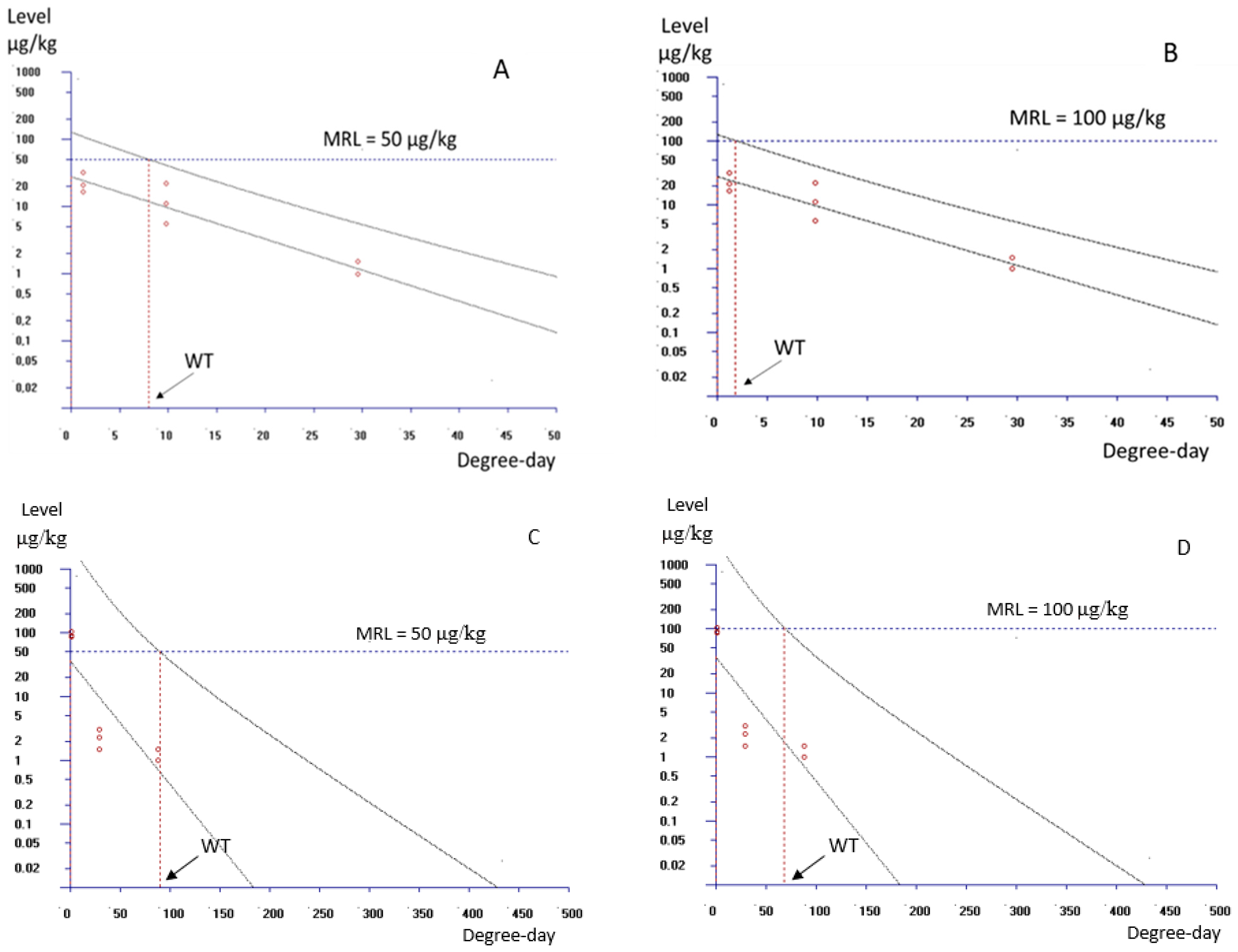
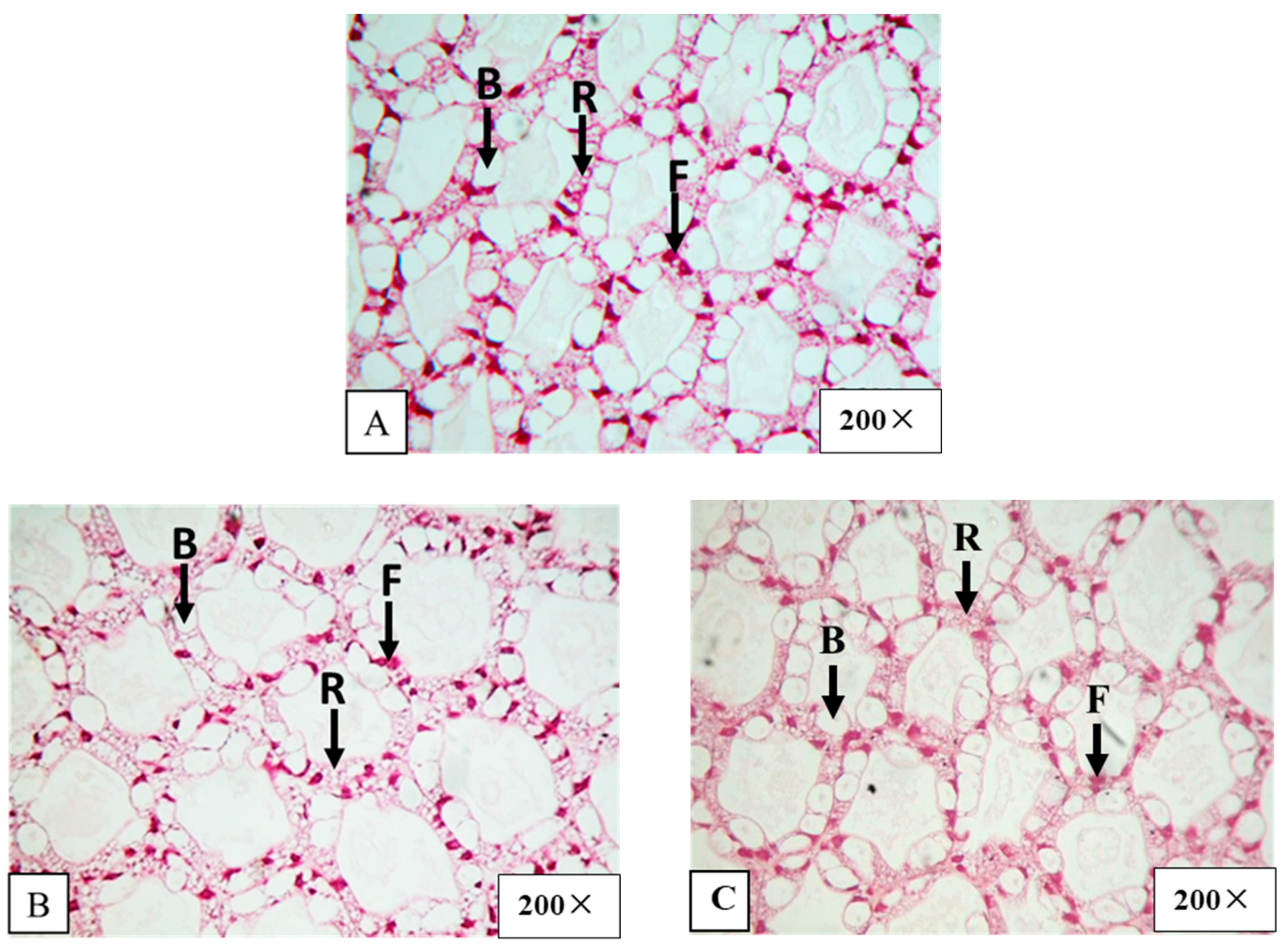
| Time (min) | Flow Rate (mL/min) | Solvent A (%) | Solvent B (%) |
|---|---|---|---|
| 0 | 0.3 | 20 | 80 |
| 1 | 0.3 | 60 | 40 |
| 1.5 | 0.3 | 80 | 20 |
| 3.0 | 0.3 | 80 | 20 |
| 3.01 | 0.3 | 20 | 80 |
| 6.0 | 0.3 | 20 | 80 |
| Parameters | Results | |
|---|---|---|
| LOD (µg/kg) | 1.5 | |
| LOQ (µg/kg) | 4 | |
| CCα (µg/kg) | 108 | |
| Linearity (R2) | 0.999 | |
| Selectivity/specificity | Identification point | 5 |
| Relative standard deviation of the ion ratio (%) | ±15 | |
| Minimum acceptable retention time (%) | 0.3 | |
| Matrix effect (%) | 11.63 | |
| Ruggedness (%) | 93 | |
| Repeatability at 3 concentrations (measured concentration in µg/kg, n = 7) (%) | 0.1 MRL (10 µg/kg) | 5.95 |
| 1 MRL (100 µg/kg) | 4.97 | |
| 1.5 MRL (150 µg/kg) | 3.64 | |
| Within-laboratory reproducibility at 3 concentrations (measured concentration in µg/kg, n = 3) (%) | 0.1 MRL (10 µg/kg) | 6.00 |
| 1 MRL (100 µg/kg) | 5.14 | |
| 1.5 MRL (150 µg/kg) | 3.79 | |
| Recovery at 3 concentrations (min–max, n = 3) (%) | 0.1 MRL (10 µg/kg) | 88–107 |
| 1 MRL (100 µg/kg) | 89–106 | |
| 1.5 MRL (150 µg/kg) | 90–102 | |
| PK Parameter | Hepatopancreas | Plasma |
|---|---|---|
| Cmax (mg/kg; mg/L) | 19.45 ± 2.10 | 0.184 ± 0.061 |
| Tmax (h) | 1 ± 0.20 | 4 ± 1.07 |
| AUC0−24 h (mg.h/kg; mg.h/L) | 199.64 ± 16.22 | 2.15 ± 0.35 |
| kel (1/h) | 0.062 | 0.079 |
| T1/2el (h) | 11.23 | 8.78 |
Disclaimer/Publisher’s Note: The statements, opinions and data contained in all publications are solely those of the individual author(s) and contributor(s) and not of MDPI and/or the editor(s). MDPI and/or the editor(s) disclaim responsibility for any injury to people or property resulting from any ideas, methods, instructions or products referred to in the content. |
© 2024 by the authors. Licensee MDPI, Basel, Switzerland. This article is an open access article distributed under the terms and conditions of the Creative Commons Attribution (CC BY) license (https://creativecommons.org/licenses/by/4.0/).
Share and Cite
Huynh, T.K.D.; Scippo, M.-L.; Devreese, M.; Croubels, S.; Nguyen, Q.T.; Douny, C.; Dang, T.H.O.; Le, Q.V.; Tran, M.P. Pharmacokinetics and Withdrawal Times of Cefotaxime in White Leg Shrimp (Litopenaeus vannamei) after Oral Administration. Fishes 2024, 9, 232. https://doi.org/10.3390/fishes9060232
Huynh TKD, Scippo M-L, Devreese M, Croubels S, Nguyen QT, Douny C, Dang THO, Le QV, Tran MP. Pharmacokinetics and Withdrawal Times of Cefotaxime in White Leg Shrimp (Litopenaeus vannamei) after Oral Administration. Fishes. 2024; 9(6):232. https://doi.org/10.3390/fishes9060232
Chicago/Turabian StyleHuynh, Thi Kim Duyen, Marie-Louise Scippo, Mathias Devreese, Siska Croubels, Quoc Thinh Nguyen, Caroline Douny, Thi Hoang Oanh Dang, Quoc Viet Le, and Minh Phu Tran. 2024. "Pharmacokinetics and Withdrawal Times of Cefotaxime in White Leg Shrimp (Litopenaeus vannamei) after Oral Administration" Fishes 9, no. 6: 232. https://doi.org/10.3390/fishes9060232
APA StyleHuynh, T. K. D., Scippo, M.-L., Devreese, M., Croubels, S., Nguyen, Q. T., Douny, C., Dang, T. H. O., Le, Q. V., & Tran, M. P. (2024). Pharmacokinetics and Withdrawal Times of Cefotaxime in White Leg Shrimp (Litopenaeus vannamei) after Oral Administration. Fishes, 9(6), 232. https://doi.org/10.3390/fishes9060232






